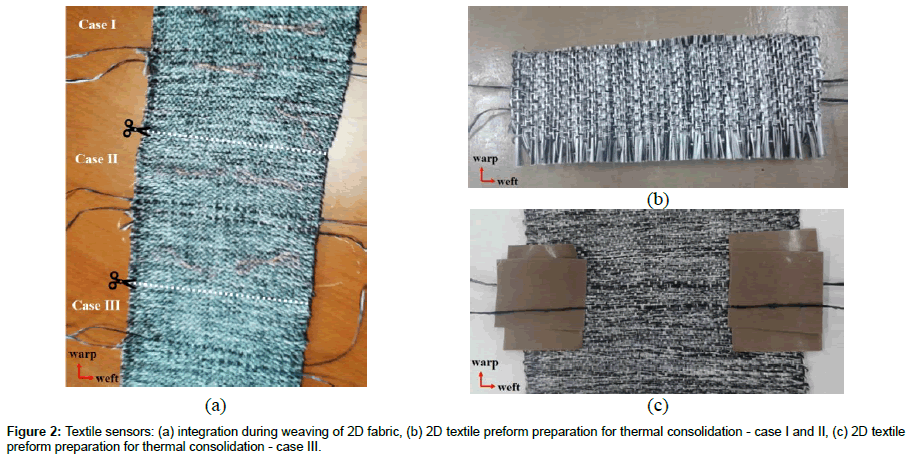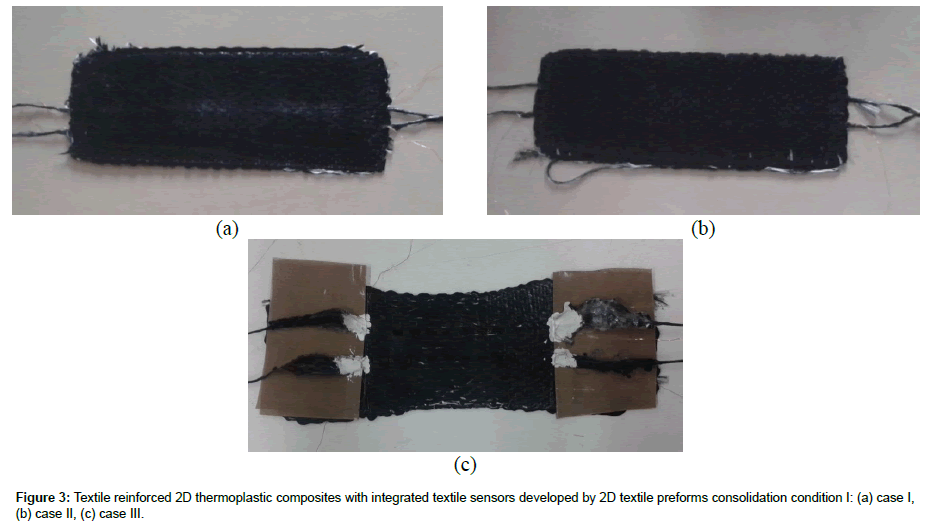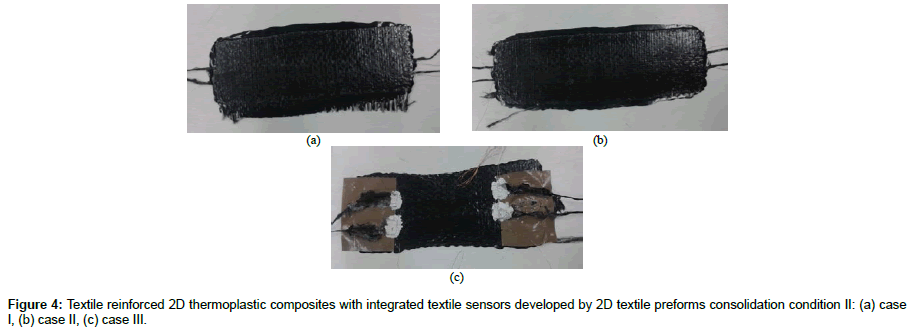Research Article, J Fashion Technol Textile Eng S Vol: 4 Issue: 0
Textile Sensors Validatıon to Perform In Situ Structural Health Monitorıng of Textile Reinforced Thermoplastic Composites
Ivona Jerkovic1, Ana Marija Grancaric1* and Vladan Koncar2
1Faculty of Textile Technology, Department of Textile Chemistry and Ecology, University of Zagreb, Croatia
2Ecole Nationale Supérieure des Arts et Industries Textiles, GEMTEX laboratory, Roubaix, France
*Corresponding Author : Ana Marija Grancaric
Professor, Faculty of Textile Technology, , Department of Textile Chemistry and Ecology, University of Zagreb, Croatia
Tel: +38514877360
Fax +38514877355
E-mail: amgranca@ttf.hr
Received: December 12, 2017 Accepted: February 28, 2018 Published: March 05, 2018
Citation: Jerkovic I, Grancaric AM, Koncar V (2018) Textile Sensors Validatıon to Perform In Situ Structural Health Monitorıng of Textile Reinforced Thermoplastic Composites. J Fashion Technol Textile Eng S4:018. doi:10.4172/2329-9568.S4-018
Abstract
Smart textile approach to realize textile sensors compatibility with composite technology is a very promising solution today. Optimisation of sensors need to carry out in order to prepare sensors having negligible affect on reinforcement geometrical and mechanical properties. Weaving of 2D fabrics due to checking the thermo-forming consolidation of textile sensors inserted is an important step to perform in situ structural health monitoring of composites. In this work, E-glass/polypropylene sensors based on poly (3,4-ethylenedioxythiophene)poly (styrenesulfonate) polymer complex were studied. Textile sensors showed resistance to high temperature and pressure by giving electrical resistance responses after 2D textile preforms consolidation and possibility to validate composites developed during tensile loading in situ.
Keywords: Smart textile; Textile sensors; 2D weaving fabrics; Composites; Electrical resistance; In situ structural health monitoring
Introduction
Textile reinforced composites have been increasingly studied during the last decade due to their remarkable features such as corrosion, chemical and impact resistance, dimensional stability, design flexibility, suitable electromagnetic properties, temperature tolerance, etc [1,2].
Smart textile approach in order to realize textile sensors compatible with composite technology is very promising solution today. However, optimisation of sensors need to carry out in order to prepare sensors having negligible affect on reinforcement geometrical and mechanical properties [1,2]. Recently, interest has been focused on the possibility to develop these sensors based on Intrinsically Conductive Polymers (ICPs) also called “synthetic metals”. Polypyrrole (PPy), polythiophene (PTh), polyaniline (PANI) and poly(3,4-ethylenedioxythiophene) (PEDOT) are mostly used a conducting polymers with a broad range of electrical conductivity from 10-10 to 10+6 Scm-1. ICPs are composed of polymer chains containing of alternating single and double bonds called conjugated double bonds. Electrons are able to move from one end of the polymer to the other through the extended p-orbital system [3-6].
Commercially available smart textile products where conductive polymers have a crucial role for their development are medical textiles, protective clothing, touch screen displays, flexible fabric keyboards, and sensors for various areas of application [7].
Like other ICPs, PEDOT has a stiff conjugated aromatic backbone structure, which makes it insoluble in most organic and inorganic solvents. Polystyrene sulfonic acid (PSS), a water-soluble polyanion, can be used during the polymerization of PEDOT as a charge balancing dopant. Polymer complex PEDOT:PSS exhibits good stability, transparency and great environmental stability [8-11].
Conductive yarns as textile sensors are integrated in textile structures by various technologies such as weaving, knitting, braiding, etc. However, their integration during textile structures development is a very complex process [7,12-14].
In this work, E-glass/polypropylene sensors integrated in weft direction during weaving of 2D fabrics at computer controlled hand weaving loom were studied through several 2D textile preforms prepared according to diverse conditions.
Materials and Methods
Laboratory device and plexiglass chamber were developed for a novel roll to roll yarn coating in GEMTEX laboratory, ENSAIT, France, to produce textile sensors [15]. Three cases of textile sensors integration in weft direction during weaving of 2D fabrics were prepared (Figure 1). For textile sensors production, two conductive coatings, 8% poly (3,4ethylenedioxythiophene) poly (styrenesulfonate) (PEDOT:PSS) CLEVIOS F ET (Heraeus)/Latex Appretan 96100 (Clariant), were applied to the E-glass/polypropylene commingled yarn (PD Fiberglass) (Table 1) between protective coatings of acrylic esters, Latex Appretan 96100 [16]. Copper twisted wires (Conrad), with diameter of 0.20 mm, were inserted around conductive coated yarn before last protective coating applied by paintbrush.
| Yarn | GF/PP commingled | |
|---|---|---|
| Fineness (tex) | 842.13 | |
| Diameter (μm) | 798 | |
| Density (g/cm3) | 1.682 | |
| Mass content (%) | 71:29 | |
| Volume content (%) | 46:54 | |
| Filament | GF | PP |
| Diameter (μm) | 14.50 | 42.90 |
| Number (%) | 88 | 12 |
| Density (g/cm3) | 2.60 | 0.90 |
Table 1: Yarn and filament characteristics.
In case I and II, copper twisted wires were inserted around conductive coated yarn at distance of 5 cm. Silver drops (RS components) were added at places where copper twisted wires have been inserted around conductive coated yarn before last protective coating applied by paintbrush.
In case III, sensor yarns with 10 cm length of conductive layers onto the yarn without the last protective coated applied were integrated during weaving of 2D fabrics. Copper twisted wires were inserted after 2D textile preforms consolidation in related composites at the end of conductive coated area, and silver drops were added. Therefore, the last protective coating was not applied onto sensor yarns to perform electrical resistance measurements. In cases I and II three layers of 2D textile preforms with the middle layer with integrated GF/PP sensors and in case III with the first layer with integrated GF/PP sensors at 2 cm distance were consolidated at the heating press (Dolouets, Soustons, France) during 5 min under following conditions:
(i) condition I - temperature of 185°C and pressure applied of 2-3 MPa,
(ii) condition II - temperature of 185°C and pressure applied of 4-5 MPa.
Results and Discussion
Three cases of GF/PP sensors integration during weaving of 2D fabrics and later on 2D textile preforms preparation for consolidation step were shown in Figure 2.
The weaving step of 2D fabrics, 4-end satin with repetition (warp density, 4 ends/cm and weft density, 6 ends/cm), thickness ~2.660 mm, by computer controlled hand weaving loom ARM equipped with Selectron command box was considered as the preliminary work to check the thermo-forming consolidation “capacities” of developed composites with textile sensors integrated in the weft direction in order to perform in situ structural health monitoring.
Three cases of textile sensors integrated in composites after diverse thermal consolidation conditions I and II for textile preforms are shown in Figures 3 and 4. Dimensions of developed composites are 8 cm x 21 cm x 0.15 cm.
Textile sensors need to show resistance to high temperature and pressure to validate consolidated structures during tensile loading in situ and to detect possible damages such as cracks, fibre breakage and delamination. Related electrical resistance measurements of GF/PP sensors were presented in Tables 2 and 3.
| Case | Sample label | Sensor electrical resistance R2 (Ω) | Sensor electrical resistance after integration in 2D fabric R2 (Ω) | Sensor electrical resistance after consolidation of 2D textile preform R2 (kΩ) |
|---|---|---|---|---|
| I | GF/PP_Sy-sp07-1 | 570 | 600 | 12 |
| GF/PP_Sy-sp07-2 | 770 | 840 | 36 | |
| Average | 670 | 720 | 24 | |
| Standard deviation | 141 | 170 | 17 | |
| II | GF/PP_Sy-sp03-1 | 740 | 850 | 13 |
| GF/PP_Sy-sp03-2 | 570 | 620 | 42 | |
| Average | 655 | 735 | 28 | |
| Standard deviation | 120 | 163 | 21 | |
| III | GF/PP_Sy-sp01-1 | / | / | 75 |
| GF/PP_Sy-sp01-2 | / | / | 10 | |
| Average | / | / | 42 | |
| Standard deviation | / | / | 46 |
Table 2: Electrical resistance measurements of GF/PP sensors after production, integration in 2D fabric and consolidation of 2D textile preform under condition I.
| Case | Sample label | Sensor electrical resistance R2 (Ω) | Sensor electrical resistance after integration in 2D fabric R2 (Ω) | Sensor electrical resistance after consolidation of 2D textile preform R2 |
|---|---|---|---|---|
| I | GF/PP_Sy-sp07-3 | 720 | 1080 | 10 MΩ |
| GF/PP_Sy-sp07-4 | 880 | 930 | 10 MΩ | |
| Average | 800 | 1005 | 10 MΩ | |
| Standard deviation | 113 | 106 | 0 MΩ | |
| II | GF/PP_Sy-sp03-3 | 540 | 640 | 160 kΩ |
| GF/PP_Sy-sp03-4 | 780 | 450 | 31 kΩ | |
| Average | 660 | 545 | 96 kΩ | |
| Standard deviation | 170 | 134 | 91 kΩ | |
| III | GF/PP_Sy-sp01-3 | / | / | 90 kΩ |
| GF/PP_Sy-sp01-4 | / | / | 550 kΩ | |
| Average | / | / | 320 kΩ | |
| Standard deviation | / | / | 325 kΩ |
Table 3: Electrical resistance measurements of GF/PP sensors after production, integration in 2D fabric and consolidation of 2D textile preform under condition II.
Sensor electrical resistances after textile sensors integration in 2D fabrics were slightly higher compared to their electrical resistances after production for case I and II. Similar values confirm their good integration during weaving of 2D fabrics acting also as a part of the structures produced.
According to results after consolidation step of 2D textile preforms under condition I, case I showed very low electrical resistance values of textile sensors, 12 kΩ and 36 kΩ (24 kΩ as the average value).
Taking into account that higher pressure has to be used for composites preparation, case II gives positive sensors electrical resistance responses after consolidation step of 2D textile preforms under condition II. This means that the electrical resistance values of textile sensors are still quite low, 31 kΩ and 160 kΩ (96 kΩ as the average value), particularly in comparison to case I. Case III could be taken as the second option but only data of textile sensors electrical resistance were possible to obtain after composites development, 90 kΩ and 550 kΩ (320 kΩ as the average value), due to copper wires insertion and silver drops addition after thermal consolidation of 2D textile preform(s).
Hence, case II under pressure applied of 4-5 MPa and temperature of 185°C during consolidation (condition II) was chosen for deep study through larger number of 2D textile preforms as adequate option for structural health monitoring of textıle reınforced thermoplastıc composıtes in situ during tensile loading.
Conclusion
Sensor electrical resistances after textile sensors integration in 2D fabrics were slightly higher compared to their electrical resistances after production. Similar values confirm their good integration during weaving of 2D fabrics acting also as a part of the structures produced. Taking into account that high pressure during composites preparation has to be used, composite with textile sensors integrated showing electrical resistances 31 kΩ and 160 kΩ after consolidation of 2D textile preforms at ktemperature of 185°C and pressure applied of 4-5 MPa during 5 min was chosen for deep study. Hence, a higher number of composites under structural and consolidation conditions defined in this work needs to be prepared for structural health monitoring of textıle reınforced thermoplastıc composıtes in situ during tensile loading.
Acknowledgement
The paper is a part of the EU project “MAPICC 3D” results within the call NMP-FP7- 2010-3.4-1, numbered with 263159 entitled: One-shot Manufacturing on large scale of 3D up graded panels and stiffeners for lightweight thermoplastic textile composite structures. The authors would like to thank the European Commission for funding of the project.
References
- Encinas N, Lavat-Gil M, Dillingham RG, Abenojara J, Martíneza MA (2014) Cold plasma effect on short glass fibre reinforced composites adhesion properties. Int J Adhes Adhes 48: 85-91.
- Kandola BS, Krishnan L (2014) Fire performance evaluation of different resins for potential application in fire resistant structural marine composites.
- Trifigny N, Kelly F, Cohrane C, Boussu F, Koncar V, et al. (2013) PEDOT:PSS-based piezo-resistive sensors applied to reinforcement glass fibres for in situ measurement during the composite material weaving process. Sensors13: 10749-10764.
- Cochrane C, Koncar V, Levandowski M (2007) Design and development of a flexible strain sensor for textile structures based on a conductive polymer composite. Sensors7: 473-492.
- Kaur G, Adhikari R, Cass P, Bown M, Gunatillake P (2015) Electrically conductive polymers and composites for biomedical applications. RSC Adv5: 37553-37567.
- Yoon H (2013) Current trends in sensors based on conducting polymer nanomaterials. Nanomaterials 3: 524-549.
- Grancaric AM, Jerkovic I, Koncar V, Cochrane C, Kelly FM, et al. (2017) Conductive polymers for smart textile applications. J Ind Text 1-31.
- Gentile F, Coppedè N, Tarabella G, Villani M, Calestani D, et al. (2014) Microtexturing of the conductive PEDOT:PSS polymer for superhydrophobic organic electrochemical transistors. BioMed Res Int 2014: 1-10.
- Calvert P, Duggal D, Patra P, Agrawal A, Sawhney A (2008) Conducting polymer and conducting composite strain sensors on textiles. Mol Cryst Liq Cryst484: 291/[657]–302/[668].
- Zhou J, Lubineau G (2013) Improving electrical conductivity in polycarbonate nanocomposites using highly conductive PEDOT/PSS coated MWCNTs. ACS Appl Mater Interfaces5: 6189-6200.
- Zeng H, Zhu X, Liang Y, Guo X (2015) Interfacial layer engineering for performance enhancement in polymer solar cells. Polymers 7: 333-372.
- Grancaric AM, Jerkovic I, Dufour C, Boussu F, Legrand X, et al. (2015) Glass/polypropylene sensor yarns integration during weaving of 2D structure.
- Cristian I, Nauman S, Cochrane C, Koncar V (2011) Electro-conductive sensors and heating elements based on conductive polymer composites in woven fabric structures.
- Nauman S, Cristian I, Boussu F, Koncar V (2013)Piezoresistive, fibrous sensorfor on-line structural health monitoring of composites. In: Smart sensors for industrial applications. Iniewski K (ed). CRC Press. Taylor & Francis Group. Boca Raton, Florida. USA.
- Jerkovic I, Dufour C, Legrand X, Tao X, Boussu F, et al. (2015) E-glass/polypropylene sensor yarns developed by roll to roll coating procedure.
- Jerkovic I, Koncar V, Grancaric AM (2017) New textile sensors for in situ structural health monitoring of textile reinforced thermoplastic composites based on the conductive poly (3, 4-ethylenedioxythiophene)-poly (styrenesulfonate) polymer complex. Sensors 17: E2297.
 Spanish
Spanish  Chinese
Chinese  Russian
Russian  German
German  French
French  Japanese
Japanese  Portuguese
Portuguese  Hindi
Hindi 






